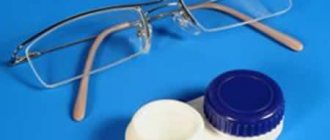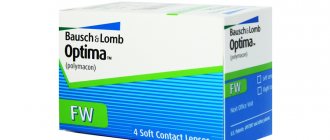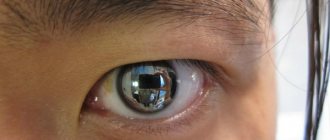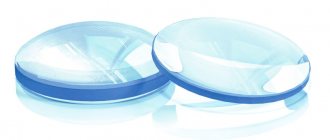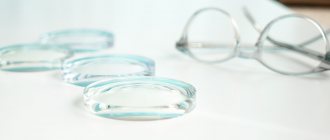Glasses can be hazardous to health if you do not pay attention to the lenses. Cheap lens materials do not restore vision, but only make it worse. This is confirmed by oculists. When purchasing an accessory, the refractive index, type of raw material (plastic or glass) and coating are considered. Having studied these parameters, a person will quickly select a safe product.
The editors of the YaNashla website have prepared for you a rating of the best manufacturers of glasses lenses for 2021.
Pay attention to the material
Eyeglass lenses are made of inorganic glass or medical plastic. The first option is traditional and is obtained by melting glass components. It is used in most products; the material is durable and reliable. There is also a drawback: high cost compared to plastic models.
To add more density, change refraction, or change other technical characteristics, the chemical composition of the material changes during production.
Organic models are made from synthetic polymer materials. To increase strength and service life, special additives are used. Such models can be made from thermosets and thermoplastics. The difference is that the first group is destroyed under the influence of high temperatures, while the second only melts and hardens if the heating is stopped.
Advantages of glass models
Glass lenses are in demand among most buyers. The positive aspects include:
- High resistance to scratches due to the hardness of the material. The buyer does not have to buy a durable case made of plastic or wood. To store glasses, a regular bag will do.
- Do not wear out over time. Plastic lenses lose their original appearance every month, especially if they are neglected. This does not threaten glass representatives.
- Do not deteriorate from frequent exposure to sunlight or when working in a room with high temperatures.
- Good surface adhesion allows you to choose any frame.
Mineral lenses are prescribed by doctors to those patients who have a large deviation from unity. Other options will not suit them. The reason for this decision is the high degree of refraction with a smaller material thickness. This has a positive effect on the comfort of wearing glasses.
But even this solution has some disadvantages:
- Fragility. Despite the wear resistance and durability, the material will easily break if dropped or hit by an object. The last situation is the most terrible, since the glass is located near the eyes and if destroyed, the lenses will fall inside the organ. This will cause serious damage to the retina.
- Not suitable for correcting vision in children.
Features of the plastic version
When organic material first appeared, it was not widely used due to some disadvantages. Therefore, optometrists deliberately ignored it and prescribed only mineral lenses to patients. The situation changed when a new development method was invented that is safe and reliable. If previously only inorganic glass was purchased, now it is being replaced by polymer compounds. The efficiency of modern models is the same as that of traditional designs.
The advantages of this solution include:
- Light weight, which reduces the load on the bridge of the nose and increases comfort.
- Impact resistance is achieved due to the characteristics of the material. This increases safety, since upon impact the lenses will not shatter into a thousand pieces, which will preserve an important organ.
- You can use any dyes, which allows you to get dozens of shades that are suitable for specific situations.
- Do not deteriorate from frequent exposure to ultraviolet rays.
To make the product less scratchable, some manufacturers apply a thin protective layer. It increases strength and prolongs the service life of glasses by 2-3 times compared to cheap analogues.
Mineral glass lenses
Mineral lenses are those made from clear and colored inorganic glass. What is it? This is a solid amorphous transparent material obtained by cooling the melt of glass-forming components (oxides of various chemical elements - silicon, boron, lead, phosphorus, etc.). By varying the composition of the oxides, it is possible to obtain inorganic glasses with different optical characteristics, such as: refractive index, density, Abbe number. Mineral spectacle lenses are distinguished by exceptionally high and stable optical properties, as well as scratch resistance. Optical materials made from mineral glass are superior to organic materials in terms of abrasion resistance, hardness, heat resistance and light resistance, and they also have an order of magnitude lower indicators of optical inhomogeneity and light scattering. The coefficient of linear thermal expansion of optical plastics is ten times greater than that of mineral glass, so the optical properties of plastics, especially the refractive index n, depend on temperature. Most polymer materials from which plastic lenses are made are characterized by a decrease in the refractive index with increasing temperature, and this change is (1.0–2.0) 10–4 per 1 °C, which is approximately an order of magnitude higher than that of inorganic glass. It is these properties of polymers that make it impossible to use them for the manufacture of precision optical parts, but they successfully compete with mineral glass in those areas where high impact strength and low weight are required.
The listed advantages of spectacle lenses made of mineral glass determine their use for a number of purposes:
- Mineral lenses are still used to make a number of safety glasses. In some industrial environments, protective lenses made of plastic last only a few days, after which their surface becomes covered with numerous scratches and other damage, preventing their further use.
- The color of mineral lenses dyed in the mass is extremely stable. These lenses will not fade when exposed to sunlight or atmospheric air like tinted organic lenses.
- Many types of special lenses are made only from mineral glass - to protect the eyes from X-rays, laser radiation, radiation, and they are also used for installation in special-purpose sunglasses.
- Mineral glass lenses are a more stable base for anti-reflective coatings . compared to plastic lenses. Moreover, the parameters of the technological process of their application are almost the same for mineral lenses from different manufacturers.
Benefits of mineral lenses for glasses wearers:
- excellent and stable optical properties;
- greater resistance to scratches compared to organic lenses;
- better adhesion of optical coatings to the surface of lenses;
- solution to the problem of “thick lenses” of high refractions using lenses with a high refractive index: lenticular and aspherical surface design make the lenses thinner, flatter, lighter.
Disadvantages of mineral glass lenses:
- higher specific gravity than plastic lenses leads to greater weight of finished glasses;
- less resistance to impact loads, therefore mineral glass lenses are strictly unacceptable when making glasses for children, as well as for adults whose work or leisure activities involve the possibility of eye injury;
- limited selection of designs.
What is important to know about refractive index
Thickness and volume are determined only by this parameter, but in addition, the refractive index affects the percentage of reflection from the surface. It is necessary to select glasses correctly, as convenience depends on it.
The higher the refractive index, the better the optical properties. For example, the lens will be thinner and weigh less. However, the cost of such execution will increase.
When buying glasses at an optical salon, it is important to adhere to the prescription prescribed by the ophthalmologist. It shows the recommended refractive index. For example, if a person has severely impaired vision, a model with a high indicator of this parameter is selected.
The frame also affects refraction. For example, when buying glasses with a plastic frame, it is recommended to select lenses with a lower coefficient. Because the thickness will not stand out much, but the mass of the product will increase.
What are the lenses covered with?
Glasses are a fragile item and not always reliable. Some models break due to accidental drops, while others get scratched the day after purchase. To reduce lens wear and increase service life, protective coatings are applied.
Today at least 6 layers are used to prevent:
- The appearance of scratches. This affects the usability and lifespan of the product;
- Formation of dirt and water accumulation. This makes cleaning the glass easier;
- Dust adhesion and static accumulation;
- Negative effects of radiation from monitors, tablets or smartphones;
- Negative effects on the eyes from bright light;
- The appearance of glare, which helps improve transparency and, therefore, reduces eye strain.
There can be either one or 3-4 coatings. Models with a large number of protective layers are called multifunctional. They eliminate not one, but several serious problems at once. Most often, it is customary to apply a coating that increases strength, repels water and reduces the load on the visual organ.
What you need to know when choosing lenses for glasses
How to choose the right one, what you need to know:
Optical performance
Optical indicators are center-to-center distance and diopters. These indicators are determined by an ophthalmologist after conducting the necessary examinations to determine visual acuity. It is important that when making pince-nez, the indicators are met, since otherwise there will be no benefit.
Refractive index
An equally important indicator is the refractive index. The higher the indicator, the thinner the pieces of glass and their curvature will be. If the lens has a small refractive index, then it will narrow the eyes and face in the area of the lenses. More elegant frames can be chosen with a high coefficient.
Material
The best optics today are made from glass and polycarbonate (plastic). Each has its own advantages and disadvantages. The choice is individual. It is important that glass has a higher refractive index than polycarbonate. However, plastic is easier to scratch but has high impact resistance.
Anti-reflex lens coating
This coating improves optical properties thanks to a special coating technology. It makes it 10% more transparent. The anti-reflex coating makes it more comfortable and the eyes more protected under heavy strain from fatigue. Another advantage of this coating is good vision of objects in the evening and at night.
Useful selection tips
Which ones are better to choose for children, which ones will be unbreakable and safe. The glass pieces must be made of polycarbonate. Colored spectacle lenses are recommended for professional drivers. They will enhance the contrast and protect from the bright light of lanterns and headlights.
Optics with anti-reflective coating are indispensable for those who take a lot of photographs or work in front of the camera. To work at a computer, you need glasses that reduce eye strain. These eyepieces keep your eyes healthy and can be worn if you have good vision.
Choosing the right lenses for computer work
The glow from the monitor can destroy even healthy eyes. The muscles of this organ are under constant tension, and if a person is still sitting in a poor posture and is at an unsafe distance from the monitor, the chance of developing the disease in the future increases.
When working at a monitor, over time you may experience dryness, severe burning, redness, and sometimes watery eyes. This will have a bad effect on eye health, and no vitamins will help restore previous visual acuity.
For those who constantly work in front of a monitor, ophthalmologists recommend purchasing computer glasses. They are suitable for everyone, including people who do not need correction and see perfectly far and near. A protective coating is applied to the surface of this material, which reduces the effects of blue light and also improves clarity. The eyes will become less strained, and this has a positive effect on performance.
Popular varieties
Buying the right glasses will help reduce eye strain and improve your quality of life. The frame is the last thing to pay attention to; the main thing is to understand the glass and optical characteristics. You can buy glasses yourself, but it is better to contact an ophthalmologist who will conduct a thorough analysis and write out the only correct prescription. With this piece of paper, a person will go to the optician and in 5 minutes will find a suitable option, without overpaying.
Aspherical models are designed for people with high myopia. A distinctive feature of this design is its thickness and low weight. This allows you to insert glass into any frame, which increases convenience. Another advantage of this option is that the size of the eyes does not change, unlike analogues that have thick lenses.
With age, vision deteriorates both near and far. It becomes more difficult to see letters, faces or objects. That's why some people carry multiple glasses with them at once. For example, some for reading newspapers or books, and others for driving. They are selected individually for each user.
Carrying 2-3 pairs with you is not always convenient, so we developed progressive lenses. The advantage of the model is the division into near and far zones. Thanks to high-quality optical properties, the eyes can easily move from reading advertisements at a long distance to answering SMS close up.
Modern manufacturers offer hundreds of different models with unique frames and outer coverings. However, only an ophthalmologist can choose the right option. Consultants in an optical salon will not be able to fully select glasses for each person if they do not have a special device for eye diagnostics.
Lenses and prevention of eye diseases
Continued research into the physiology of vision and the study of factors that provoke the development of eye diseases have led to the creation of spectacle lenses and coatings that more effectively protect the eyes and help maintain their health for many years. Coatings such as Crizal Sapphire UV have emerged that provide best-in-class lens clarity and aesthetics in any light direction across a 360° range. Zeiss Group has introduced UV protection technology in its ZEISS UVProtect spectacle lenses. These lenses bridge the gap between light rays with a wavelength of 380 and 400 nm, completely blocking the ultraviolet range of the spectrum up to 400 nm. The technology is protected by three patents based on new UV absorbers combined with a new anti-reflective coating that guarantees UV protection without any compromise on aesthetics or optical properties. In addition, technologies have emerged, such as BBGR's BLUV Xpert, that provide exceptional two-in-one protection against ultraviolet radiation and high-energy blue light in the visible range.
Rating of bifocal lens manufacturers
WEIYA
A Chinese manufacturer that produces bifocal lenses with different refractive indexes. Any design can be selected, but the spherical one is more popular. The main material is high-strength glass, which eliminates the risk of various damages.
The products of this company are suitable for every user, and the cost is not as high as that of most analogues. Any vision correction will take place quickly and without any problems. A person will be able to both distinguish objects in the distance and read newspapers. There are two optical zones that have a positive effect on convenience.
Sold at a price: from 600 rubles.
WEIYA spectacle lens
Advantages:
- Two zones;
- Variety of designs;
- A suitable option for correction;
- Affordable price.
Flaws:
- Not detected.
RODENSTOCK
A popular company that has been on the market for 140 years. Each product is distinguished by high quality and durability. Models with lenses from this company are suitable for both vision correction and everyday wear. To prevent the product from deteriorating, there is a multifunctional coating. It prevents the accumulation of water and dust, and also shows high resistance to scratches.
You can buy glasses from this company at any optical store. The design is selected individually, which allows you to choose a unique model that will be worn comfortably. The small mass of the finished product makes it possible to reduce the load on the bridge of the nose. In addition to bifocal products, the buyer can order glasses for sports, driving or comfortable reading.
The average cost is 4,550 rubles.
RODENSTOCK spectacle lens
Advantages:
- Comfortable to wear;
- Individual design;
- High-quality correction;
- Various refractive indices;
- Possibility of purchasing to order.
Flaws:
- Not detected.
OSA International
A good model in the mid-price segment, which is suitable for correcting visual function. The refractive index depends on the specific model, but models with a value of 1.56 are popular. The design is standard, but still remains attractive. Lenses can be inserted into almost any frame. They are made of special plastic with multi-coating, which improves the quality and strength characteristics.
With glasses from this company, vision correction will be comfortable. In addition, the company offers to purchase glasses for any situation and with different shades. The protective layer is scratch resistant and prevents dust accumulation.
The average cost is 1,750 rubles.
spectacle lens OSA International
Advantages:
- Light weight;
- Big choice;
- Convenience;
- Attractive design.
Flaws:
- Not found.
Famous lens manufacturers
Modern technologies make it possible to produce glasses of any shape and with purely individual lens properties.
Essilor is an international company that has been producing spectacle lenses for the second century. Over many years of experience, this company has acquired an impeccable reputation and many satisfied clients. It is notable for the fact that it not only produces lenses, but also independently conducts all the research, developing the technological process.
Essilor was the first to market lenses made from polymer materials. The leader in the optical industry has produced renowned lenses coated with Crizal. It protects the surface of the lens from dirt, water, scratches, and glare.
Hoya - these lenses originated from Japan and first appeared in 1941. The company is the progenitor of the technology of applying antireflection coating to glass lenses. It is famous for its strict quality control and wide range of products.
Rodenstock is a company from Germany that has been doing its business since the end of the 19th century. In addition to spectacle lenses and frames, it produces optical equipment. Rodenstock is a symbol of German quality and modern technology.
Carl Zeiss - this company began with a small workshop producing and selling mechanical and optical instruments. Carl Zeiss, the founder of the company, created the first apochromatic lenses.
Choosing which lenses for glasses are best from the companies presented is quite difficult. After all, all famous manufacturers have a rich, more than 100 years of experience and modern technologies in their arsenal. It is these combinations that allow them to remain market leaders for many years.
Rating of the best manufacturers of lenses for office glasses
ZEISS
The company produces and produces lenses for cameras, glasses, cinema lenses, as well as microscopes and medical devices. The main advantage of this option is high quality and reliability. Thanks to this, a person receives not just a good, but a durable product that will help increase productivity.
Finding a suitable design will not be difficult, since plastic, not glass, is used. There is a multi-coating that guarantees protection against scratches and high blue light exposure. The average refractive index is 1.5, which is a suitable solution for every user. Small thickness reduces the weight of the product.
The average cost is 2,975 rubles.
ZEISS spectacle lens
Advantages:
- Modern technologies are used during development;
- Strength;
- Does not load the bridge of the nose;
- Quality.
Flaws:
- Not detected.
TOP VISION
The manufacturer produces lenses using Free Form technology. This solution allows you not to limit yourself to one design, but to choose a convenient model for each person. In the manufacture of products, only proven materials are used, which reduces errors and has a positive effect on quality. Cleaning the plastic takes minimal time and leaves no streaks.
The refractive index is 1.5. The design is selected individually for each customer. Glasses can be used both for work and at home. The multifunctional coating guarantees long service life and scratch resistance.
Sold at a price: from 3,600 rubles.
TOP VISION spectacle lens
Advantages:
- Convenient shape;
- Suitable option for office work;
- Design;
- Good refractive index;
- Light weight.
Flaws:
- Not detected.
NIKON
A popular manufacturer of cameras and lenses, it offers an excellent solution for home and office – Home&Office 1.5 ECC Blue. The refractive index is 1.5, which is a suitable solution for every user. The design is aspherical, therefore suitable for people with a high degree of myopia. But, besides this, you can find a model for healthy people. The product is made of medical plastic. There is a multi-coating that will protect against bright light and ultraviolet rays.
The average cost is 6,400 rubles.
NIKON spectacle lens
Advantages:
- Convenient shape;
- Dozens of models;
- Efficiency;
- Life time;
- They don't scratch.
Flaws:
- High price.
Product characteristics
Korean companies offer the best options for lenses for glasses. Here you can see optics made from mineral (glass) or polymer (plastic) materials.
Both options have a refractive index of 1.5 to 1.74. As it increases, they become thinner, lighter and more attractive in appearance.
High index lenses are often designed for a high level of refractive power. This type transmits light worse. Therefore, it requires a special coating that brightens the optics and eliminates glare.
High index is also used in rimless frames and in pediatric use.
Different lens options have different aspherical and spherical designs.
The second type is traditional. It is he who is most often found wearing glasses. Optics are characterized by the fact that on both sides of its surface there is a convex shape for farsightedness or a concave shape for myopia. But the products become quite thick and somewhat distort the view.
The aspherical version is thinner because one side is flat. The field of view is not distorted and clearly displays the distance to the object in question. The lens becomes lighter and does not disturb the proportions of the eyes behind the glasses.
In general, Korean optics have a long service life. It is not damaged by minor impacts, and its glass does not become cloudy.
Most products provide protection from UV rays. This makes them great for being outside. They also serve excellently as driver's glasses.
Korean lenses have high transmission capacity, as their coating meets polarization, anti-reflection and anti-reflection requirements.
Most users choose Hill products (n=1.56). The company produces products with a coating that prevents rapid wear and damage to its surface. The range includes multi-layer anti-reflective and hydrophobic options. There are also coatings that protect against heavy dirt.
CHEMI-COMPUTRON lenses (n=1.56) are available with different types of coatings:
- antistatic;
- water-repellent;
- multilayer antireflective;
- with protection from electromagnetic radiation, etc.
High-index lenses “CRYOL (LOTOS) Aspheric (n=1.67)”, prescribed to people with various visual impairments, are becoming a particularly preferred option. They make a person who is forced to constantly wear glasses attractive. The optics are made using interesting design solutions, and their thin edges are suitable for any type of frame.
The company also produces products with water-repellent, multi-layer hardening, anti-reflective and reliable sun protection coatings.
Popular progressive lens manufacturers
HOYA
An expensive option that is convenient to wear anywhere and any time. The coating protects the eyes from fatigue. The design is made in a modern style, which is suitable for every user. The low weight makes it easy to install the product in any frame. The company's most popular model is EnRoute 1.67 Progressive.
The average cost is 16,900 rubles.
HOYA spectacle lens
Advantages:
- Refractive index – 1.67;
- Modern design;
- Protective covering;
- Suitable for daily use.
Flaws:
- Not found.
SHAMIR
Budget solution with an average refractive index of 1.6. The design has a beautiful appearance. The lenses are made of polycarbonate, which results in low cost. The material is inferior to medical plastic and glass, but it has no significant disadvantages. Therefore, a person can comfortably wear glasses for a long time and not feel their presence on the bridge of the nose.
Sold at a price: from 5,360 rubles.
spectacle lens SHAMIR
Advantages:
- Price;
- Good material;
- Refractive index;
- Multi-coating.
Flaws:
- Not found.
ESSILOR
A good company that produces glasses of various types and purposes. In the catalog you can find both correctional models and products for daily use. A popular variety is X'ion Ormix 1.61 Acclimates Brown Crizal Alize UV (R). The product is fully consistent with its price, as it offers the user high quality and a service life of several years. No scratches or stains will disturb the buyer throughout the entire period of use.
Sold at a price: from 13,500 rubles.
ESSILOR spectacle lens
Advantages:
- Reliable protective coating;
- Convenience;
- Low weight;
- Strength indicators.
Flaws:
- There are no significant ones.
Spectacle lens materials
As before, the most popular material for spectacle lenses is CR-39, from which up to 70% of the total volume sold on the global optical market is made. Recently, no fundamentally new materials have appeared. The latest innovations, which have been on the market for several years now, are the following developments from Mitsui Chemicals, Inc., the world's leading manufacturer of highly refractive materials for spectacle lenses under the MR brand: UV + 420cut, which filter out blue radiation, and MR 8 Plus - with higher resistance to shock loads. New optical materials also include MR-160, which contains components obtained by processing annually renewable raw materials - plants. MR-160 is not inferior in light transmission to conventional material with a refractive index of 1.60, obtained from petroleum products, and even surpasses it in some other parameters. As experts in the field of vision correction note, photochromic lenses are in steady demand, and this trend will continue in the future. The color palette of such lenses is expanding - this year Transitions Optical introduced four new colors in the activated state: sapphire, amethyst, amber, emerald, which will help glasses users create a unique fashionable image, while maintaining all the advantages of photochromic lenses produced using Signature technology. The demand for polarized lenses is growing - today in Europe they make up 3% of all lenses sold, and in America - 10%. The most popular brand of polarized lenses is NuPolar
from Younger Optics, but many companies have begun producing their own polarized lenses.
